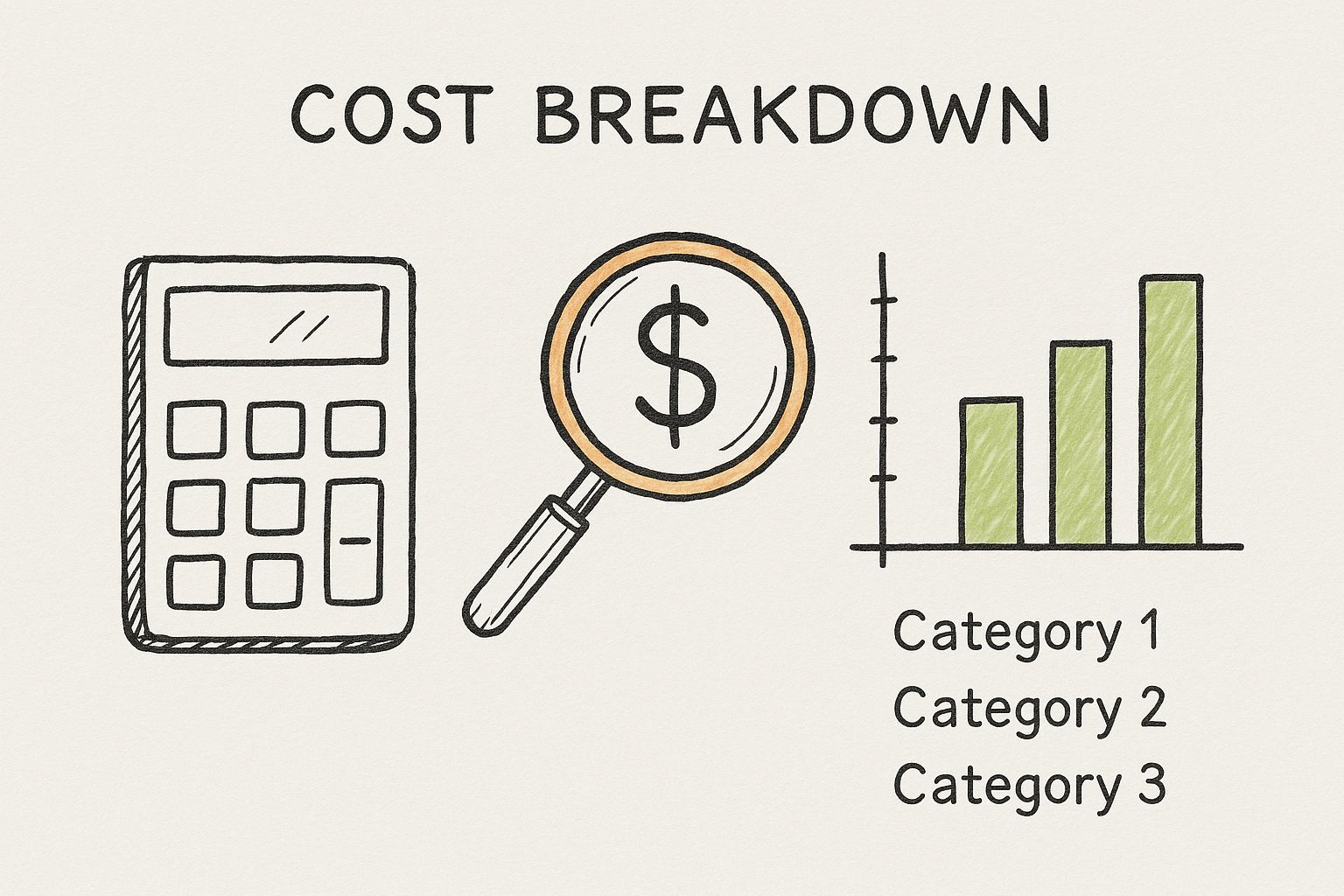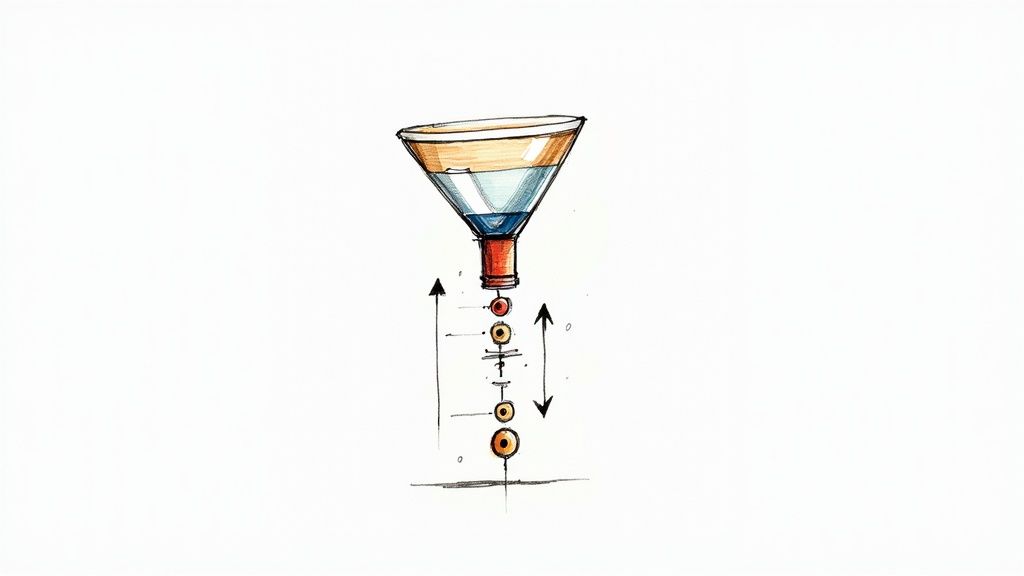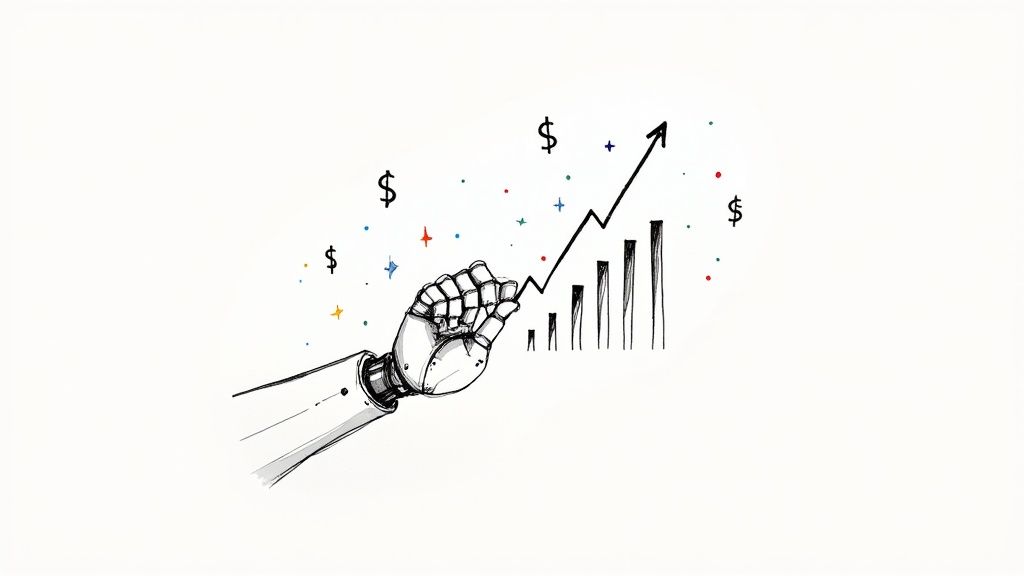How to Slash Your Customer Acquisition Costs—And Get More Profitable
Want to lower your customer acquisition cost (CAC)? First, you have to know what it is. It's simple: add up all your sales and marketing costs over a set period, then divide that by the number of new customers you brought in. This number is your baseline. It's the starting line for making smarter, more profitable decisions.
First, Nail Your CAC Calculation
You can't fix what you don't measure.
Trying to slash your CAC without a clear number is just guessing. Before you touch a single tactic, you need an honest, all-in picture of what you currently spend to get one customer.
This isn’t just ad spend. A true CAC calculation includes every dollar you sink into sales and marketing over a specific timeframe—usually a month or quarter. That means digging up every obvious expense and all the hidden costs, too.
What to Include in Your Calculation
To get an accurate CAC, be ruthless. Leaving things out gives you a false sense of security and leads to bad decisions.
Here’s your tally list:
Marketing & Ad Spend: The easy one. Your budget for Google, Facebook, influencer campaigns, content promotion—all of it.
Team Salaries: The big one people forget. Salaries and commissions for your entire marketing and sales team are direct acquisition costs.
Tools & Software: Every subscription counts. Your CRM, email platform, analytics tools—if it helps you get customers, it goes in the mix.
Creative & Production Costs: Paid a freelancer for ad creative? A videographer for a product demo? Those costs go in here.
Once you’ve got that total, the formula is simple:
(Total Sales & Marketing Costs) / (Number of New Customers Acquired) = Your Customer Acquisition Cost
This infographic breaks down the moving parts. Look at every piece of the puzzle.

As the visual shows, the key is to inspect every cost, calculate with precision, and track performance so you can make informed moves.
Go Deeper: Calculate CAC by Channel
A blended, company-wide CAC is a start, but the real power is in breaking it down by channel.
Knowing your CAC for paid social versus content marketing is where the game-changing insights are. This is how you find your workhorses and kill the cash-burners.
The table below shows a simple example. By tracking spend and new customers for each channel, you can instantly see which avenues are most efficient.
CAC Calculation by Channel Example
Marketing Channel | Total Spend | New Customers Acquired | Calculated CAC |
|---|---|---|---|
Google Ads | $5,000 | 33 | $151.52 |
Facebook Ads | $3,500 | 45 | $77.78 |
SEO/Content | $2,000 | 44 | $45.45 |
Email Marketing | $500 | 25 | $20.00 |
From this data, it's clear: SEO and Email Marketing are hyper-effective, while Google Ads is the most expensive way to get a new customer.
This doesn't mean you automatically kill your Google Ads budget. It's a signal. It forces you to ask why one channel is so much more efficient and what you can learn from it to optimize the others. This granular view is your first real step toward a smarter spending strategy.
Plug Leaks in Your Conversion Funnel
Pouring money into ads without optimizing your website is like filling a bucket with holes. Every visitor who leaves without converting is wasted ad spend, driving your CAC up for no reason.
The fix isn't more traffic; it's converting the traffic you already have.
This is where Conversion Rate Optimization (CRO) becomes your most powerful lever for slashing CAC. Small, strategic tweaks to your funnel produce huge gains. Instead of paying more to attract new eyes, you make your existing pathways work harder.

Sharpen Your Landing Pages
Your landing page is the first handshake. If it's confusing, slow, or unconvincing, they'll bounce, and you paid for a click that went nowhere.
Start here: align your headline and ad copy perfectly. If someone clicks an ad for "Vegan Leather Boots," your landing page must scream "Vegan Leather Boots"—not just "Women's Footwear." This immediate message match confirms they're in the right place.
Next, check your page's flow.
Is the call-to-action (CTA) obvious? Use action-oriented words like "Get Your Free Quote" instead of a passive "Submit."
Is the form too long? Only ask for what's essential. Every extra field is a reason to bail.
Does the page load fast? A one-second delay kills conversions by 7%. It’s a silent killer.
A/B testing isn't optional. Test one major element at a time—the headline, CTA button color, the main image. A small lift in conversion rate from 1% to 2% effectively cuts your cost per conversion in half.
Simplify the Checkout Process
For e-commerce, checkout is where fortunes are made or lost. The average cart abandonment rate is 70%—a massive leak in your funnel. Your only goal here is to make buying frictionless.
First, offer a guest checkout. Forcing account creation is a top conversion killer. You can always ask them to create an account after the purchase.
Also, be transparent about all costs upfront. Surprise shipping fees are the #1 reason for cart abandonment. Show the full price as early as possible.
Write Calls-to-Action That Actually Convert
Your CTA is the final command. It needs to be compelling, clear, and valuable. Vague buttons inspire no one.
Instead of this:
"Learn More"
"Continue"
"Download"
Do this:
"See Pricing Plans"
"Start My 30-Day Free Trial"
"Get My Free Ebook Now"
The difference is specificity. The user knows exactly what happens when they click. These micro-optimizations add up, driving higher conversions without increasing ad spend. While average CAC can range from $66 in fashion to $91 in jewelry, funnel optimization is the universal strategy to beat those benchmarks.
For a deeper dive, explore these essential conversion rate optimization tips to start plugging leaks today.
Turn Customer Retention into Your Growth Engine
Stop chasing new customers when your most profitable audience is right in front of you. The relentless pursuit of new leads is an expensive game. Shifting focus from pure acquisition to robust retention is one of the smartest financial moves you can make.
The math is simple: keeping a customer is dramatically cheaper than getting a new one. This directly lowers your effective CAC by boosting the lifetime value (CLV) of every person you’ve already paid for.
Build Loyalty That Pays Dividends
Loyalty isn't just about repeat purchases. It's about building a connection that makes your brand the obvious choice. A well-designed loyalty program is a fantastic tool for this, rewarding customers for sticking around and making them feel valued.
Think beyond simple points-for-purchase. Get creative and offer perks people actually want:
Early access to new product drops.
Invitations to members-only events or webinars.
Tiered rewards that unlock better benefits as customers spend more.
This screenshot from LoyaltyLion shows how a dedicated platform can help you structure these programs, turning casual buyers into committed brand fans.
The bottom line: a good loyalty program gives customers a tangible reason to come back, which directly boosts repeat purchase rates and CLV.
A solid customer retention strategy is non-negotiable. For more ideas, explore these effective strategies to improve customer retention.
Turn Happy Customers into Your Best Sales Team
The ultimate low-cost acquisition channel? Word-of-mouth. Put it on steroids with a referral program.
Your happiest customers are your greatest advocates. Giving them a structured, rewarding way to spread the word is a no-brainer.
An effective program offers a dual-sided incentive—a reward for the referrer and a deal for the new customer. This creates a powerful, self-perpetuating cycle of low-cost acquisition.
Key Insight: Referred customers are cheaper and more valuable. They arrive with built-in trust from a friend’s recommendation, which leads to higher conversion rates and better long-term loyalty.
The data backs this up. Over the past eight years, CAC has surged by as much as 222%, making pure acquisition an increasingly expensive game.
But businesses that increase their repeat purchase rates—which hover between 15% and 30% in e-commerce—see a huge jump in CLV and become less reliant on costly ads. On top of that, referred customers also have a 16% higher CLV.
Focus on keeping the customers you have. You'll increase revenue and build an organic marketing engine that reduces your dependence on expensive ad platforms. For a deeper dive, check out our guide on how to increase customer retention for more actionable steps.
Use AI and Automation for Smarter Spending
If you're still making marketing decisions on guesswork, you're burning cash. Plain and simple. Using artificial intelligence (AI) and automation isn't a trend—it's how you make smarter spending decisions and slash your CAC.
Modern tools do the heavy lifting, replacing gut feelings with cold, hard data. Stop wasting money on audiences that won't convert and laser-focus your budget where it actually works.

Target Your Audience with Pinpoint Accuracy
One of the fastest ways to drain your budget is by showing ads to the wrong people. AI-powered platforms go beyond basic demographics, analyzing thousands of behavioral data points in real time.
What does that look like? Instead of vaguely targeting "women aged 25-40," you can target individuals who recently searched for your competitors, visited specific product pages, and are showing clear online behaviors that signal purchase intent. It's about finding people ready to buy, right now.
AI algorithms spot patterns a human could never see, concentrating your ad spend only on high-probability conversions. This is a direct line to a lower CAC.
Automate Ad Bidding for Maximum ROI
Trying to manually manage bids on platforms like Google Ads is a losing game. It’s too time-consuming, and you can't react fast enough to shifts in the ad auction.
Automated bidding tools use machine learning to adjust your bids in real time, 24/7, to hit your goal—be it maximizing conversions or hitting a target ROAS. It’s a hands-off approach that saves hours and prevents overspending during lulls while capitalizing on high-value moments.
These systems make sure every ad dollar works as hard as possible. For industries like e-commerce and SaaS, adopting AI has led to CAC reductions of up to 50%. As acquisition costs climb, using AI isn't just smart, it's a competitive necessity.
Score Leads to Empower Your Sales Team
Not all leads are created equal. A huge driver of high CAC is your sales team wasting time on low-quality prospects who were never going to buy.
Predictive lead scoring models fix this. By analyzing data from your CRM, these systems assign a score to every new lead, ranking them by their likelihood to convert.
High-Scoring Leads: Flagged as "hot" and routed immediately to your sales reps. No more letting good leads go cold.
Low-Scoring Leads: Dropped into an automated email nurturing sequence, freeing up your team to close deals.
Focus your team on the best opportunities. You'll improve sales efficiency, shorten the sales cycle, and ensure your most expensive resource—people's time—is spent generating revenue.
Paid ads get you a quick traffic spike, but it's rented attention. The second you stop paying, the visitors vanish.
To actually lower your CAC for the long haul, build an asset—something that grows in value over time. That asset is a solid SEO and content marketing machine.
Unlike ads that constantly drain your budget, a single great piece of content can pull in organic traffic for years. It's a compounding effect. Your upfront investment of time keeps paying off, steadily driving down your blended CAC.
Focus on Problems, Not Just Keywords
First, a mental shift: stop chasing keywords and start solving real-world problems for your ideal customers.
Someone searching "how to fix a leaky faucet" has an urgent problem. If you create the most helpful, step-by-step guide on that topic, you earn their trust and their click.
This problem-first approach naturally uncovers high-intent keywords—the exact phrases people use when they're ready for a solution. These are the visitors most likely to convert because you're meeting them right where they are.
Pro Tip: Don't just write blog posts. Create free, genuinely useful tools like calculators, checklists, or simple templates. These things are link magnets and can easily become your most powerful, low-cost lead generators.
Create Content Pillars for Authority
Instead of scattering your efforts across a dozen random topics, go deep. Build "content pillars."
A content pillar is a massive, in-depth guide covering a core topic in your industry from every angle. It's your definitive resource.
From this central pillar, spin off smaller, related pieces—blog posts, social media updates, videos—that all link back to the main guide. This strategy is a one-two punch:
It cements your brand as the go-to expert.
It creates a powerful internal linking structure that Google loves, boosting your rankings across the board.
This approach takes patience. SEO is a long game, but the payoff is a steady stream of highly qualified, "free" traffic. For a practical guide on using AI to speed this up, check out this AI SEO checklist. It’ll help you build out your content machine way more efficiently.
Your Questions About Reducing CAC, Answered
Let's cut to the chase. Navigating customer acquisition costs can feel like solving a puzzle with missing pieces. You're not alone. Here are the most common questions I get, with straightforward answers.
What’s a Good CAC to LTV Ratio?
The magic number is a 1:3 ratio between Customer Acquisition Cost (CAC) and Lifetime Value (LTV). Or better.
What does that mean? For every $1 you spend to acquire a customer, you should generate at least $3 from them over their lifetime. It's the classic sign of a healthy, sustainable business.
If your ratio is below 1:3, that's a red flag. You're either overspending to get customers or they aren't sticking around long enough to pay you back. On the flip side, a ratio of 1:5 or higher is fantastic—it means your marketing is incredibly efficient and you can probably spend more aggressively to scale up.
How Often Should I Calculate My Customer Acquisition Cost?
For most businesses, calculating it monthly is the sweet spot.
This gives you a regular pulse on performance, letting you see trends and the real impact of your campaigns. It’s frequent enough to spot problems before they escalate, but not so often that you get lost in daily noise.
The exception: if you're running a short, intense campaign—like a Black Friday blitz—check in weekly, or even every few days. This lets you pivot fast if something isn’t working. The most important thing is to be consistent so you can make clean, apples-to-apples comparisons over time.
Key Takeaway: Don't just calculate CAC to have a number. A consistent schedule turns this metric from a report card into a powerful tool for deciding where to put your money next.
Which Marketing Channel Has the Lowest CAC?
There is no single "cheapest" channel. The most cost-effective channel for you depends entirely on your industry, your audience, and your product.
That said, for long-term value, organic channels almost always win. Think SEO, content marketing, and word-of-mouth referrals.
Sure, they require an upfront investment of time (and sometimes money), but they don't run on a pay-per-click meter. Once your blog post ranks on Google or your referral program takes off, it becomes a machine that brings in new customers for a tiny fraction of what you'd spend on paid ads. When you turn off a Google ad, the leads stop. When you rank #1 for a key term, the leads keep coming.
Ready to stop overspending and start growing smarter? Viral Marketing Lab provides the tools, templates, and expert-backed blueprints you need to slash your CAC and build a sustainable marketing engine. Get access to our entire suite of resources at https://viralmarketinglab.com.










